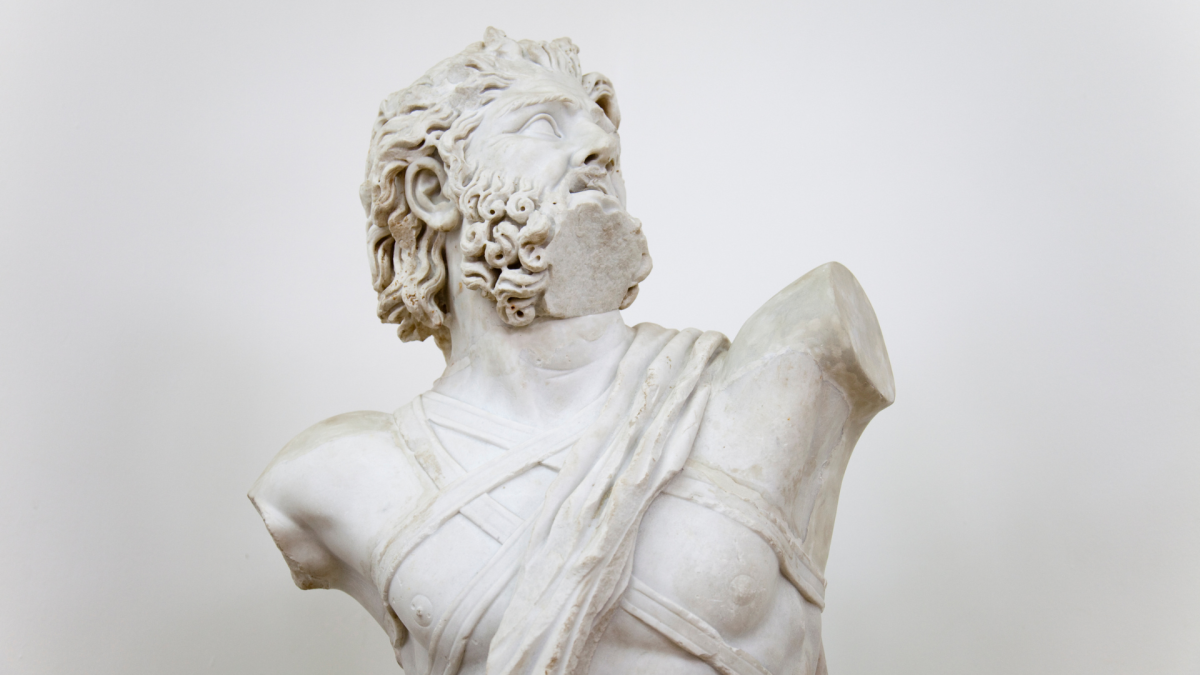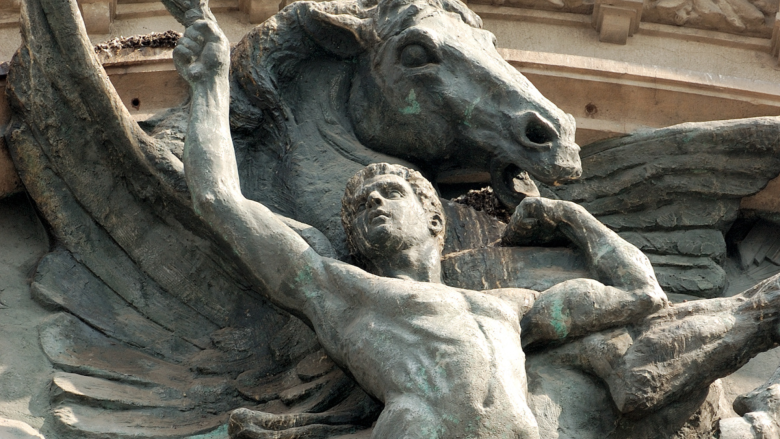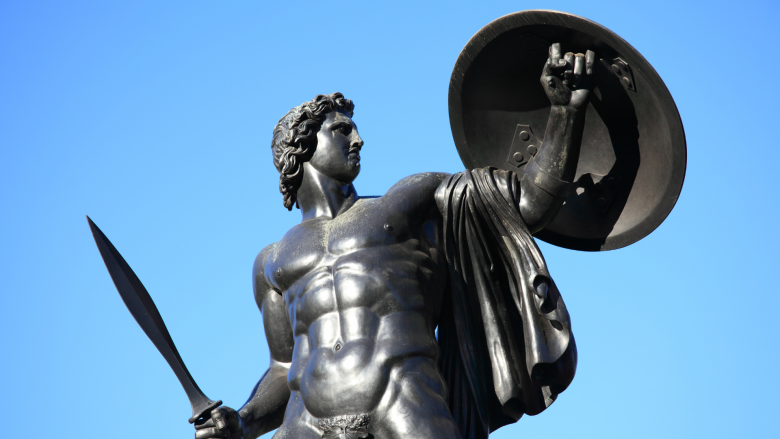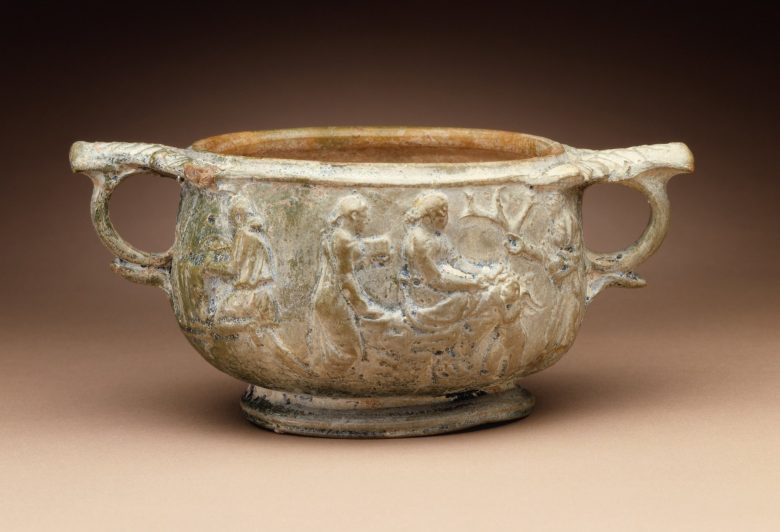The Mythical Inventor: Daedalus

In Greek mythology, Daedalus was a skillful architect and craftsman, seen as a symbol of wisdom, knowledge, and power.
Among his most famous creations are the wooden cow for Pasiphaë, the Labyrinth for King Minos of Crete which imprisoned the Minotaur, and the wings that he and his son Icarus used to escape Crete.
Origin of Daedalus
Athenian architect, sculptor, and inventor of machines, son of Palaemon and grandson of Erechtheus or, postponing his birth by two generations later, son of Eupalamus and Alcippi who had roots in the generation of the first king of Athens, Cecrops. His Athenian origin is mentioned in the 5th century by Ferekidis and Plato. The two-generation shift of his birth and the invention of new ancestors justify his coexistence with Theseus.
Daedalus in Athens
Daedalus worked in Athens and Talos, the son of his sister Perdikas, studied with him. It is said that Talos was distinguished for his skill and the day he discovered the saw, inspired by the jaw of a snake, Daedalus was so jealous that he killed him, throwing him from the Acropolis. However, the crime was revealed and Daedalus, after being convicted by the Court, fled to Crete, finding asylum in the palace of Minos.

Icarus_Son of Daedalus
Daedalus in Crete
First Version
Daedalus became a regular architect and sculptor of King Minos. He built palaces with luxurious halls, statues, altars, baths, and the labyrinth, according to the standards of the Egyptian labyrinth, a marble dance hall where Ariadne with they danced for her during the great festivals of the year.
When Minos’ wife, Pasiphae, fell in love with a bull, she asked Daedalus to help her satisfy her lust. Daedalus made a model of a wooden cow, hollow inside.
From this paradoxical union of the bull and Pasiphae, the Minotaur was born. The Minotaur who lived in the Labyrinth, also the work of Daedalus, fed on human flesh. This act provoked the wrath of Minos. Another version attributes Minos’ displeasure to the fact that the Athenian craftsman gave his daughter, Ariadne, the famous bribe, with which Theseus, king of Athens, managed to escape from the Labyrinth, after first killing the Minotaur. When Minos was informed of Daedalus’ actions, he imprisoned him and his son Icarus in the Labyrinth.
However, the ingenious Daedalus made wings. Which, after attaching them to his shoulders with a candle, gave him and his son freedom. Icarus, did not obey not his father’s advice not to get too close to the sun. Therefore, the material of the wings melted and Icarus fell into the sea and drowned.
Second Version
A more rational approach to the myth was that Pasiphae, to help Daedalus escape punishment from Minos, boarded a ship with Icarus’s son, whom he had acquired from Naukratis, a slave of the king, whose name is related to the sea, it is the one that holds the ship, a corresponding form with the navigator Nafplio, the master Nausimedon, the Oiakas who holds the rudder, that the legend makes father, the first, and brothers, the other two, of the wise Palamidis. Sailing east of the Cyclades, Icarus tripped and fell into the sea. Daedalus buried him on the island he named Ikaria and the sea around the island.
Third Version
Others say that Hercules found and buried the young man’s corpse. Out of gratitude to Hercules, Daedalus made a statue of him and offered it to Heraklion of Thebes and until the years of Pausanias, the Thebans displayed it as the work of Daedalus. Variation wants the statue of Hercules in physical dimensions and to look so real. With natural movement and swollen muscles, the hero took it for a real man and stoned it.
Fourth Version
Another variant is based on the fact that Daedalus could only leave Crete by boat. Minos, who controlled all the ships, promised a lot of gold to anyone who found Daedalus. Because any escape route had been blocked by sea, Daedalus made the wings so that father and son could escape from the air. A more rational interpretation of this version is the following. The father and son are left in a sailing boat, which they first invented. This ship became faster than the Minoan rowers. Because the sail from afar looked like a feather, the version of the construction of the wings emerged. According to another version, Daedalus escaped to his homeland, Athens. And Minos asked for one of their own every year for food for the Minotaur.

Achilles shield made by Hephaestus
Daedalus and Hephaestus
Daedalus was similar to other inventors and inventors, such as Palamidis and Prometheus, but mainly Hephaestus, who builds the Cretan giant Talos and a harpoon on the shield of Achilles like the one that Daedalus had built for Ariadne in Knossos. In this case, it seems as if the so-called Daedalus is an old deity, corresponding to Hephaestus in the twelve gods, but he fell into oblivion.
In any case, Daedalus is related to fire, metalworking, architecture, and sculpture. While the evolution he brought about is related to the invention of new tools. Around its form and name developed a fiction about technological progress and cultural development that accompanied the political prosperity of Crete. The legend wants him to live in Athens, Crete, Sicily, and Egypt because in a way monuments had to be explained according to the Minoan culture and to indicate patterns in certain art forms.
Traces of prehistoric monuments according to the Minoans fueled the myth of Daedalus’ flight to Sicily and his stay in Egypt. There, he was said to have built the propylaea of Memphis and a large labyrinth before that of Crete. They even had a temple dedicated to him. His move from Athens to Crete indicates the spread of wood carving from Crete to mainland Greece. Here, in the formation of the myth, Athens plays an important role. To be the first to invent, and then spread it to others, was a title of honor.

Relief Skyphos with Pasiphae, Daedalus and the Heifer Photo Credit: Ashley Van Haeften
Mythology Blog Posts by Elissos Travelling Philosophy
The Unknown Story of Pasiphae
Her story is connected to her illegitimate and unnatural love for the bull that Poseidon emerged from the sea, a sign of the gods’ preference for Minos in the dispute he had with his brothers Radamanthis and Sarpedon for power. However, while this act of Poseidon secured power to Minos without bloodshed, Minos did not sacrifice the animal, as he had promised. On the contrary, he sent it to his flocks because of its beauty and to preserve its race.
Lake Korisia: The «only daughter» Lake of Crete
Here lived a beautiful daughter whose beauty was famous throughout Crete. She was the jewel of her village and her fellow villagers were proud of her and everyone loved her. But she also always managed to make them laugh and rejoice with her cute make-up and her sweet songs.
Uncovering the Symbols of the Myth of Europe
The love that inspired Zeus and her abduction by him is reminiscent of the story of Persephone and Pluto. She was also playing with her companions and was gathering flowers in a beautiful landscape on the shore of Tyre or Sidon, where her father reigned. There Zeus saw her. To approach her, he transformed into a calm white bull, with horns like a crescent moon. He went and laid down at the girl’s feet. The girl suddenly felt a desire to sit on his back. Fast as lightning, the bull got up and rushed into the sea so that Europe would not have time to get off and no one would have time to intervene. On their way to Crete, they were accompanied by dolphins, Nereids, Tritons, and God Poseidon.

